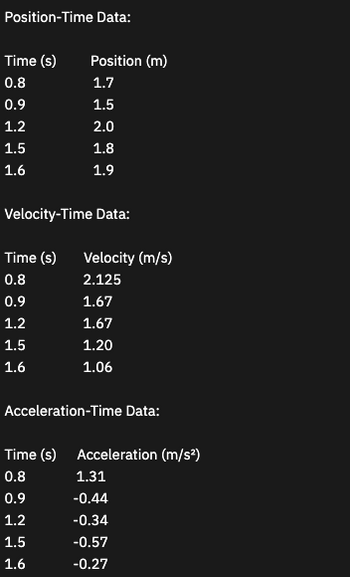
College Physics
11th Edition
ISBN: 9781305952300
Author: Raymond A. Serway, Chris Vuille
Publisher: Cengage Learning
expand_more
expand_more
format_list_bulleted
Concept explainers
Question
using the information down below generate graphs of the position-time, velocity-time, and acceleration-time data.

Transcribed Image Text:Position-Time Data:
Time (s)
0.8
0.9
1.2
1.5
1.6
Position (m)
1.7
1.5
2.0
1.8
1.9
Velocity-Time Data:
Time (s) Velocity (m/s)
0.8
2.125
0.9
1.2
1.5
1.6
1.67
1.67
1.20
1.06
Acceleration-Time Data:
Time (s) Acceleration (m/s²)
0.8
0.9
1.2
1.5
1.6
1.31
-0.44
-0.34
-0.57
-0.27
Expert Solution
This question has been solved!
Explore an expertly crafted, step-by-step solution for a thorough understanding of key concepts.
This is a popular solution
Trending nowThis is a popular solution!
Step by stepSolved in 4 steps with 3 images

Knowledge Booster
Learn more about
Need a deep-dive on the concept behind this application? Look no further. Learn more about this topic, physics and related others by exploring similar questions and additional content below.Similar questions
- Please send me answer of this question immediately and i will give you like sure sirarrow_forwardConsider the plot shown below. Which description below is consistent with the graph? position a b C time The object moves in the positive direction and then moves in the negative direction. The object moves upwards, reaches its peak and then falls with an acceleration. The object accelerates in the positive direction and then in the negative direction.arrow_forwardProvide an explanation outlining the underlying physics principle and using correct terminologies. In answering these problems, apply appropriate formulae, principles, and equations What is the instantaneous velocity of a freely falling object 10 seconds after it is released from a position of rest? What is the average velocity during this 10 second time interval? How far will it fall during this time?arrow_forward
- Please show your solution using the formulas in the picture. Thank you! QUESTION: A boy throws a stone upward from the top of a building with an initial velocity of 20 m/s. The building is 50 m high. Determine: a.) time needed for the stone to reach maximum height b.) maximum height c.) time needed for the stone to reach the level of the thrower d.) velocity of the stone at this instantarrow_forwardnot changing Learning Goal: To understand the distinction between velocity and acceleration with the use of motion diagrams. Previous Answers In common usage, velocity and acceleration both can imply having considerable speed. In physics, they are sharply defined concepts that are not at all synonymous. Distinguishing clearly between them is a prerequisite to understanding motion. Moreover, an easy way to study motion is to draw a motion diagram, in which the position of the object in motion is sketched at several equally spaced instants of time, and these sketches (or napshots) are combined into one single picture. Correct While the ball is in free fall, the magnitude of its velocity is increasing, so the ball is accelerating. Part B In this problem, we make use of these concepts to study the motion of a power ball. This discussion assumes that we have already agreed on a coordinate system from which to measure the position r (t) (also called the Since the length of v is directly…arrow_forwardPlease only tapy answerarrow_forward
- Posting second time , Previous answer was copied so i reported. Please show clear stepsarrow_forwardFor a body in constant acceleration motion, which of the numbered curves above could have the right shape if this is a velocity versus time graph? How about if it is a position versus time graph? An acceleration versus time grapharrow_forwardAn object is thrown straight up with an initial velocity Vi. The graph represents the object’s vertical displacement as a function of time. Use the graph to the right, at what time the object reaches its maximum height?arrow_forward
- Does height have an effect on the average velocity of a dropped object? Given the chart can you make a conclusion- I filled out the last column it was originally blank (when I did this I found average velocity to be inversely proportional because the average velocity slightly decreased as height increased) is this correct? I'm having troublearrow_forwardThe figure above shows a velocity vs. time graph for an object. What is the object's displacement (in m) from time 'B' to time 'C'?arrow_forwardA car is moving along a straightstretch of road. The acceleration of the car is given by the graphshown. Assume that the velocity of the car is always positive.At what time was the car moving most rapidly? Explain. Source: Larry Taylor.arrow_forward
arrow_back_ios
SEE MORE QUESTIONS
arrow_forward_ios
Recommended textbooks for you
 College PhysicsPhysicsISBN:9781305952300Author:Raymond A. Serway, Chris VuillePublisher:Cengage Learning
College PhysicsPhysicsISBN:9781305952300Author:Raymond A. Serway, Chris VuillePublisher:Cengage Learning University Physics (14th Edition)PhysicsISBN:9780133969290Author:Hugh D. Young, Roger A. FreedmanPublisher:PEARSON
University Physics (14th Edition)PhysicsISBN:9780133969290Author:Hugh D. Young, Roger A. FreedmanPublisher:PEARSON Introduction To Quantum MechanicsPhysicsISBN:9781107189638Author:Griffiths, David J., Schroeter, Darrell F.Publisher:Cambridge University Press
Introduction To Quantum MechanicsPhysicsISBN:9781107189638Author:Griffiths, David J., Schroeter, Darrell F.Publisher:Cambridge University Press Physics for Scientists and EngineersPhysicsISBN:9781337553278Author:Raymond A. Serway, John W. JewettPublisher:Cengage Learning
Physics for Scientists and EngineersPhysicsISBN:9781337553278Author:Raymond A. Serway, John W. JewettPublisher:Cengage Learning Lecture- Tutorials for Introductory AstronomyPhysicsISBN:9780321820464Author:Edward E. Prather, Tim P. Slater, Jeff P. Adams, Gina BrissendenPublisher:Addison-Wesley
Lecture- Tutorials for Introductory AstronomyPhysicsISBN:9780321820464Author:Edward E. Prather, Tim P. Slater, Jeff P. Adams, Gina BrissendenPublisher:Addison-Wesley College Physics: A Strategic Approach (4th Editio...PhysicsISBN:9780134609034Author:Randall D. Knight (Professor Emeritus), Brian Jones, Stuart FieldPublisher:PEARSON
College Physics: A Strategic Approach (4th Editio...PhysicsISBN:9780134609034Author:Randall D. Knight (Professor Emeritus), Brian Jones, Stuart FieldPublisher:PEARSON

College Physics
Physics
ISBN:9781305952300
Author:Raymond A. Serway, Chris Vuille
Publisher:Cengage Learning

University Physics (14th Edition)
Physics
ISBN:9780133969290
Author:Hugh D. Young, Roger A. Freedman
Publisher:PEARSON

Introduction To Quantum Mechanics
Physics
ISBN:9781107189638
Author:Griffiths, David J., Schroeter, Darrell F.
Publisher:Cambridge University Press

Physics for Scientists and Engineers
Physics
ISBN:9781337553278
Author:Raymond A. Serway, John W. Jewett
Publisher:Cengage Learning

Lecture- Tutorials for Introductory Astronomy
Physics
ISBN:9780321820464
Author:Edward E. Prather, Tim P. Slater, Jeff P. Adams, Gina Brissenden
Publisher:Addison-Wesley

College Physics: A Strategic Approach (4th Editio...
Physics
ISBN:9780134609034
Author:Randall D. Knight (Professor Emeritus), Brian Jones, Stuart Field
Publisher:PEARSON